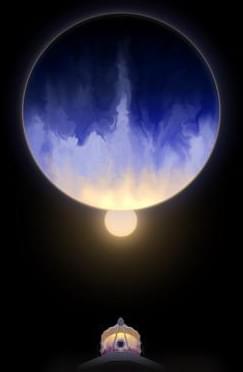Earth will get a “second moon” this weekend, but it won’t be sticking around for long.



How do the characteristics of Neptune-like exoplanets, also known as exo-Neptunes, differ from each other? This is what a recent study published in Astronomy and Astrophysics hopes to address as an international team of researchers investigated a new classification known as the “Neptunian Ridge”. This complements previous classifications of “Neptunian Desert” and “Neptunian Savannah”, with the former identifying exo-Neptunes that are rare in number but orbit very close to their parent stars while the “Neptune Savannah” describes exo-Neptunes that orbit much farther out. This study holds the potential to help astronomers better understand the formation and evolution of exo-Neptunes throughout the cosmos.
For the study, the researchers used confirmed and candidate exoplanets that comprise the Kepler DR25 catalog to ascertain the characteristic variations in exo-Neptunes while providing additional insights into the formation and evolution of exo-Neptunes, as well. In the end, they determined that this “Neptunian Ridge” exists as a middle-ground between the “Neptunian Desert” and “Neptunian Savannah”, with the former hypothesized to have formed from moving inward in their system from high-eccentricity tidal migration and the latter forming from disk-driven migration, which occurs right after planetary formation.
“Our work to observe this new structure in space is highly significant in helping us map the exoplanet landscape,” said Dr. David Armstrong, who is an Associate Professor of Physics at the University of Warwick and a co-author on the study. “As scientists, we’re always striving to understand why planets are in the condition they are in, and how they ended up where they are. The discovery of the Neptunian ridge helps answer these questions, unveiling part of the geography of exoplanets out there, and is a hugely exciting discovery.”

Twenty years ago, the MESSENGER mission revolutionized our understanding of Mercury. We sat down with project head and former Carnegie Science director Sean Solomon to talk about how the mission came together and the groundbreaking work it enabled.
Q: As the principal investigator of the MESSENGER mission, what were your personal highlights or proudest moments throughout the mission’s duration? Sean Solomon: There were many personal highlights for me during the MESSENGER mission, beginning with our initial selection by NASA in 1999 and culminating in the publication by the MESSENGER science team of all of the findings from our mission in a book published nearly two decades later.
The most challenging events in any planetary orbiter mission are launch and orbit insertion. The successful completion of those two milestones for MESSENGER—in 2004 and 2011, respectively—were sources of great pride for me in the technical expertise of all of the engineers, mission design experts, and project managers who contributed to the mission.


Can an exoplanet’s atmosphere exhibit east-west asymmetry, meaning its two edges are vastly different from each other? This is what a recent study published in Nature Astronomy hopes to address as an international team of researchers led by the University of Arizona investigated the atmosphere of WASP-107 b, which is a Jupiter-sized exoplanet located approximately 211 light-years from Earth. This study holds the potential to help astronomers better understand the formation and evolution of exoplanets and how we can hopefully find Earth-like exoplanets, as well.
“This is the first time the east-west asymmetry of any exoplanet has ever been observed as it transits its star, from space,” said Matthew Murphy, who is a graduate student at the University of Arizona Steward Observatory and lead author of the study. “I think observations made from space have a lot of different advantages versus observations that are made from the ground.”
For the study, the researchers used NASA’s powerful James Webb Space Telescope (JWST) to observe the atmosphere of WASP-107 b, which is tidally locked to its parent star, meaning one side is always facing its parent star, much like how our Moon always has one side facing the Earth. This also makes studying an exoplanet’s atmosphere tricky since astronomers can only observe the back side of the exoplanet and analyzing the starlight passing through its atmosphere. However, with the help of novel methods, the researchers were able to analyze data obtained from the front side of WASP-107 b, thus confirming its atmospheric east-west asymmetry. Additionally, WASP-107 b also exhibits low density and low gravity, resulting in its atmosphere being inflated.

I’m actually getting Starlink because it’s competitively priced, and I can walk to my local Grocery Store up the street, and order it.
President Ruto had on Monday during a business roundtable meeting revealed that Starlink’s entry into the Kenyan market faced a lot of resistance from local players who felt the foreign firm’s entry would eat into their market share.
Ruto admitted during the roundtable that Kenya would be seeking more competitors in a bid to revolutionize the digital space in Kenya.
Locally, Starlink has been well received with many Kenyan companies and business owners signaling a shift in a bid to access alternative internet options.

The James Webb Space Telescope has spotted six likely rogue worlds — objects with planet-like masses but untethered from any star’s gravity — including the lightest ever identified with a dusty disk around it.
The elusive objects offer new evidence that the same cosmic processes that give birth to stars may also play a common role in making objects only slightly bigger than Jupiter.
The James Webb Space Telescope has spotted six likely rogue worlds — objects with planetlike masses but untethered from any star’s gravity — including the lightest ever identified with a dusty disk around it.
The Overview Effect, the profound shift in human perception that occurs when one sees Earth from the outside, has the power to foster peace and global brotherhood. This underscores the urgent need for an increasing number of people, not just machines, to venture into space.
The concept encapsulated in the title above is the culmination of a two-day discussion held in New York under the auspices of the Summit of the Future. The Space Renaissance International and its 102 allied organizations, the Space 18th SDG Coalition, played a pivotal role in organizing these two events.
The first event[1] took place at the United Nations Plaza 777, NYC, in the heart of the U.N. Headquarters Plaza, thanks to the generous hosting of Henk Rogers[2]. Approximately 50 participants, both in person and virtually, engaged in a robust discussion on the necessity of amending the U.N. 2030 Agenda for Sustainable Development. The key proposal was the addition of an 18th SDG, with a specific focus on Civilian Space Development. This discussion was furthered during a Side Event[3] at the Consulate General of Jamaica in NYC, organized and hosted by Dr. Claire Nelson[4]. Robert Katz[5] and Adriano V. Autino[6] expertly co-chaired both events.

A neutron star is the remnant of a massive star (bigger than 10 Suns) that has run out of fuel, collapsed, exploded, and collapsed some more. Its protons and electrons have fused together to create neutrons under the pressure of the collapse. The only thing keeping the neutrons from collapsing further is “neutron degeneracy pressure,” which prevents two neutrons from being in the same place at the same time.
Additionally, the star loses a lot of mass in the process and winds up only about 1.5 times the Sun’s mass. But all that matter has been compressed to an object about 10 miles (16 kilometers) across. A normal star of that mass would be more than 1 million miles (1.6 million km) across.
A tablespoon of the Sun, depending on where you scoop, would weigh about 5 pounds (2 kilograms) — the weight of an old laptop. A tablespoon of neutron star weighs more than 1 billion tons (900 billion kg) — the weight of Mount Everest. So while you could lift a spoonful of Sun, you can’t lift a spoonful of neutron star.
